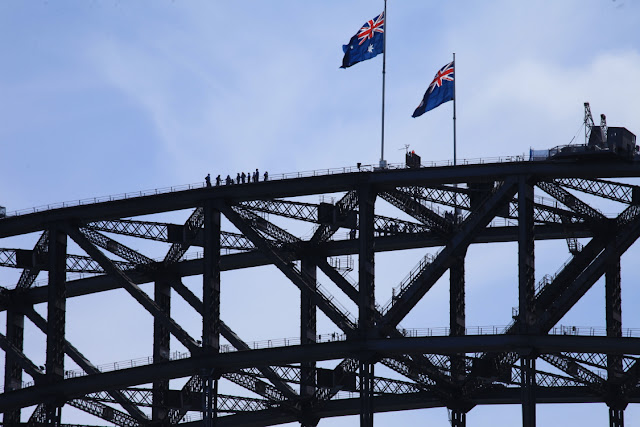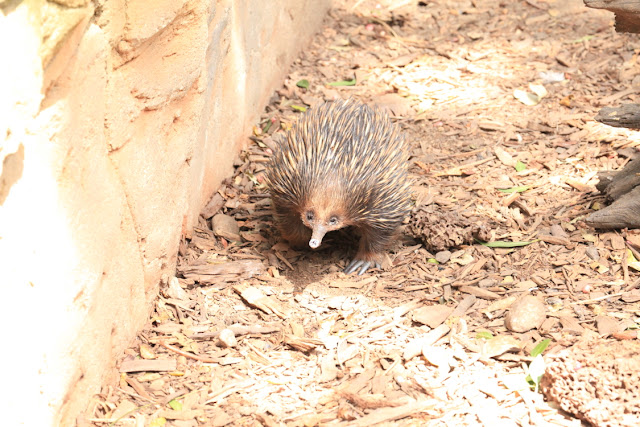Flying into Sydney International Airport, the high-rise of the city center was visible from seat 3A
Our first stop was the Royal Botanical Gardens, a space of 74 acres established in 1816 as Australia's first scientific institution. It was conveniently located across the street from our hotel.
The view from Macquarie Point was outstanding with the Harbor Bridge and the Sydney Opera House visible across the bay.
The First Fleet of eleven ships arrived from England in January, 1788 with about 1,200 people, 700 of whom were petty criminals signed on to work off their sentences for 7 years labor. In 1816, the convicts had built this "chair" at Macquarie Point for the Governor's wife, Elizabeth.
Another view from the Botanical Gardens to the city center. Sydney has a population of 4.5 million people, equalling the entire population of New Zealand.
View across Double Bay to the city. There are so many neighborhoods in Sydney and many hug the many miles of shoreline in the harbor known as Port Jackson.
One cannot go through this city without noticing the ubiquitous sandstone that is exposed in all of the road cut and in the walls of many of the historic buildings. The convicts were forever shaping this rock into building blocks for the early city.
It has natural exposures here in the Botanical Gardens
And can be seen when visiting South Head, the pinch point at the entrance to Port Jackson
It is called the Hawkesbury Sandstone and is Triassic in age, about 245 Ma - the same as the Moenkopi Formation in Arizona.
Here are some water escape structures within the sandstone
This tafoni texture is found near Manly, a northern suburb of Sydney
There are some coarse pebbles within the coarse sand, giving it the appearance of the Shinarump Conglomerate. The deposit is interpreted as fluvial (river) coming from a highland source that is now located in Antarctica.
It is everywhere seen in the city. The first settlers wanted to establish the colony at Botany Bay where James Cook had landed 18 years earlier but the shoreline there was flat and marshy, and subject to flooding. So the First Fleet relocated to Port Jackson around the corner, where the exposures of the sandstone made city building easier.
This is the famous Bondi Beach. No mystery where the sand on this beach comes from!
Sydney's most famous icon the Opera House, with a local ferry boat sailing in front of it
The unique design was submitted by a Danish architect who took part in an international competition to suggest a building for the Sydney Symphony. More mundane designs were almost chosen but this one rose to the top - even before it's structural integrity could be known.
The site was the location of an Aboriginal home, a fort, and a wharf. But in 1959 it was chosen as the location for the new Opera House.
Sepia tone image taken from the balcony on the Opera House tour
There are two main halls, the opera and the concert
This is the interior of the larger of the two halls. The seats are ergonomically designed and are quite comfortable. But more than that, they are designed so that the acoustics are just as good when few people are in the seats as when it is full.
Inside the entryway to the concert hall
View of Circular Quay from the Opera House. This is the location of the original settlement.
A glorious spring day in Sydney
View of the Harbor Bridge with hikers seen on the top span. The fare to do the span hike is $298 AUD (about $215 US) and you cannot bring your own camera so I opted out.
From beneath the Harbor Bridge
Australia produces 85% of the world's opals and some Mesozoic fossils have been opalized.
Close-up of the fossil (a pliosaur) showing the opalization in the center bone. To learn more about opals, see here.
Next it was off to the Wildlife Park in Blacktown. This is a Wombat.
The koala
A dingo
Australian frilled-neck lizard
Centralian blue-tounged lizard
Splendid tree frog
The Inland Taipan - the world's most venomous snake
The kangaroo
Kangaroo
Look at those nails!
Australian King parrot
Tasmanian Devil
The echidna
Echidna










































No comments:
Post a Comment
If your comment will not post, email me with the problem.